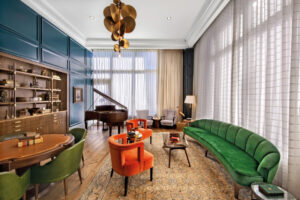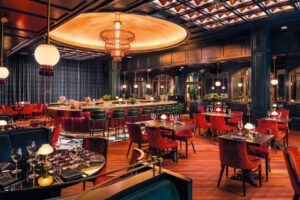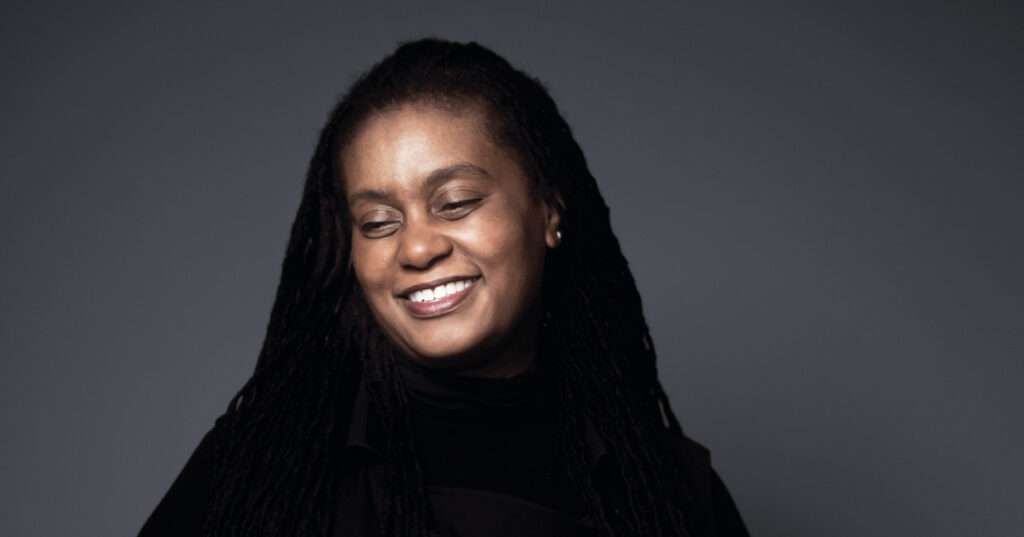An advocate for mentorship and support, Kimberly Jackson tells Sophie Harper why the hospitality design industry would benefit from a more diverse and equitable landscape.
Managing Director for AvroKO Miami, Kimberly Jackson is both manager and mentor, leading AvroKO’s multidisciplinary teams throughout the life of a project to bring ‘hospitable thinking’ into every space AvroKO designs.
Speaking to Kimberly about her career and experience entering the design industry, she tells me how she was inspired to move into interior design after studying architecture. “I studied at the Massachusetts Institute of Technology (MIT), where I pursued both architecture and visual arts along with music. I also did graduate work in architecture at Georgia Tech in Atlanta. My inspiration to move into interiors came from a combination of my love for the technicality of architecture paired with my fascination with creating and transforming more intimate spaces.”

Credit- Eric Laignel
She talks about the majority of her journey being positive, but admits that there have been challenging moments. “There were times both in my education and in my professional career that I did feel singled out or when my opinions weren’t valued because they were not the majority position. There weren’t many women professors in architecture at the time, and there were very few African Americans in the field at all. But I had to keep my eyes on my goals and let the rest melt away.”
Prior to her work at AvroKO, Kimberly designed spaces across a range of typologies including hospitality, retail, single and multifamily residential, and corporate interiors, and says she was fortunate enough to have a great mentor at an architecture firm in San Francisco who inspired her to want to offer the same support to her team later on in her career. “The principal of the firm was dedicated to developing the team and making sure everyone was given the opportunity to put their talents to work. Unlike most firms at the time, we were an incredibly diverse studio. It was a joy to work with him.”
Kimberly joined AvroKO in 2013 as a Senior Designer Consultant and says it’s the collaborative spirit, coupled with the willingness to take risks and give team members the trust to stretch their creativity, that has kept her there. “The team is truly dedicated to the creation of beautifully textured spaces. It’s a joy to see what each team member brings to their work. My current role as Managing Director started in the AvroKO New York studio. I’m grateful that I was able to expand my role by building an AvroKO team in Miami.”

Credit – Eric Laignel
“My role is multifaceted and involves overseeing various aspects of the Miami studio’s operations, design projects, and team management. A typical day for me is a balance between strategic and financial planning, creative reviews, client interactions, and project team leadership. Plus, as the newest (and smallest) studio at AvroKO, I also have to be flexible and take on additional roles as the studio grows – such as office manager and event planner.”
She tells me how she loves all aspects of her role, but that mentoring and supporting her team is her biggest priority. “I want to make sure they have the tools, resources, and guidance needed to do their best work and have a clear path for learning and growth.”
Explaining how the studio approaches each project, she says that AvroKO has a unique way of storytelling that creates complex, layered spaces where each one is unique yet still comfortable and approachable. “We are a fully collaborative studio. The Miami Design Director and I work with the design team from the very start of the project. At our team kick-off meeting, any team member may light the spark that becomes the initial idea, and we all work from there. The AvroKO design process reflects several layered ideas on any one project, so there is room for all voices. Each project starts with research and a visit to the local area so that we make sure to layer locality into our spaces.”
As a founding board member of the Hospitality Diversity Action Council (HDAC) and having previously served on the American Institute of Architects New York City Chapter (AIANY) Equity and Inclusion Committee, Kimberly tells me what an important role these organisations play in the industry. “These associations are incredible platforms for addressing issues of diversity and inclusivity, but they also act as a support system themselves to interact with a diverse set of peers. We need a more diverse and equitable landscape in the design world. It not only creates spaces where all team members can feel they can produce their best work, but it also affects the work we do. More diversity allows for more diverse perspectives, which will create comfort for a greater number of guests in our spaces.”

Credit – Seth Parker
I ask her if she has any ideas on how the industry could address underrepresentation and inclusion, and she suggests three main points:
“One – we should actively seek diverse talent at all levels of our organisations, from entry-level positions to leadership roles. Creating a diverse leadership team can help set the tone for an inclusive workplace culture.
Two – the profession should actively support mentorship programs that pair emerging designers from underrepresented backgrounds with experienced professionals from similar backgrounds. This type of program, whether internal or external to the firm, allows new designers to feel they are heard and know they are not alone.
And three – firms should expand their talent pool by offering internships from a larger range of schools and universities to provide more opportunities to students from diverse backgrounds.”
Kimberly tells me more about the HDAC and AIANY, explaining why they are such great support networks. “The Hospitality Diversity Action Council is a collective effort of owners, developers, brands, designers, and consultants to promote diversity, equity, and inclusion throughout the hospitality industry. We are a membership organisation with an immediate focus on mentorship and scholarship. Some of our members even provide direct educational opportunities for individuals looking to get into the field.
“My work with the AIANY E&I Committee focused on developing resources and toolkits for firms to implement more inclusive practices. I am also a member of the National Organization for Minority Architects (NOMA). This organisation provides outstanding support for both students and young architects starting in the field, and it is a continuing support system for architecture professionals of all levels.
“Anyone engaged in hospitality interior design can join these and other organisations as members. Not only will you help support the next generation of the profession, but members also learn from each other through sharing ideas and best practices.
At a minimum, these and other organisations host events, conferences, presentations, happy hours, and more where one can engage with a diverse group of design professionals or even sign up to mentor young designers.”

Obviously passionate about her work and the future of the design industry and diversity within the field, Kimberly thinks we’re starting to move in the right direction. “I do think there has been progress,” she says. “There is greater awareness of the importance of diversity and inclusion in the design industry. More design firms, organisations, and individuals are recognising the value of diverse perspectives in the design process – including women, people of colour, LGBTQ+ individuals, and individuals with disabilities. And while awareness is growing on the recruitment side, we still need to do better at consistently implementing inclusive design practices that consider the needs of diverse guests. I think a collective commitment to sustained action is needed to affect real change. We need a diverse profession in order to properly design for a diverse audience. Design evolves and becomes more guest friendly when a diverse set of ideas are represented.”
Talking about some of AvroKO’s projects and what Kimberly and the team are working on currently, she tells me about some of her favourite moments and projects and says how much she enjoyed seeing the Perry Lane Hotel come to life. “Savannah, Georgia, is a beautiful historic city. We were able to capture that history and craft it in a way that was fun and vibrant. Its bold use of colour and each of the hidden surprise details are a delight.”
She goes on to tell me that the studio is working on two hotel projects at the moment that she’s really excited about, but refuses to indulge my curiosity other than saying proudly that both design teams are doing amazing work on a 65-room boutique property in southern Florida and a sprawling 400+ room luxury property.
Instead of probing for more details, I ask instead what Kimberly’s hopes are for the future of the hospitality design industry.
“It is my hope that the industry continues to recognise and celebrate diversity in all its forms,” she says. “By advocating for equitable representation, we can ensure previously marginalised voices are heard and respected, leading to a stronger and more unified design community.
I also hope to see the hospitality design industry making a lasting impact on communities whether through revitalising business districts and supporting the local businesses, investing in local artisans, or creating spaces that are truly for and about the surrounding community. Design has the power to influence emotions, behaviours, and experiences. I aspire to see more projects that prioritise user well-being and empowerment, support inclusivity, and offer unique and memorable experiences for all.
“I hope the industry continues to evolve into a more diverse and inclusive landscape. By valuing a wide range of perspectives, we can foster creativity that genuinely resonates with a global audience.”



